Henry West, 1825 – 1899
microphotograph slide maker “H.W.”
by Brian Stevenson and Steve Gill
last updated July, 2024
During the
mid-1800s, the evolving technologies of microscopy and photography gave rise to “microphotographs”, miniature photographs on glass slides that can be seen clearly only through a microscope. While John Benjamin Dancer is the most famous of these microphotographers, a considerable number of other professionals and amateurs tried their hands at the art. For a reason that is unclear, the vast majority of microphotograph makers put only their initials on the slides, rather than their full names. That slides labeled “J.B.D.” were made by Dancer has long been accepted. Only recently, Stanley Warren’s insightful scholarship led to the conclusion that “A.R.” was Alfred Reeves, and both “J.S.” and “J.C.S.” were John Charles Stovin. Previously, “J.S.” was assumed to be Joseph Sidebotham, based on the circumstantial evidence that Sidebotham was a colleague of Dancer’s.
A
microphotograph maker with initials “H.W.” produced a series of at least 171
different pictures. None of photographs depicted on the known “H.W.” slides are identical to those of Dancer or other microphotographers. That fact would suggest that “H.W.” did not merely re-label others’ work, but was a legitimate photographer and microscopist in his/her own right.
Over the past several decades, numerous publications have attributed the “H.W.” microphotographs to Herbert Watkins (1828-1916). However, no known publication has cited a primary source for linking Watkins and “H.W.”. Herbert Watkins was a relatively well-known portrait photographer of the Victorian era. He produced small photographs for cartes-de-visite and other cards, many of which were distributed by Marion & Co. However, a contemporary description of Watkins' miniature photographic cards indicates that they were approximately 1/4 inch (1 cm) in diameter and were neither mounted on slides nor true microphotographs that required a microscope: “Messrs.
Marion are now carrying on a business in the production of photographic
visiting cards. The visitor who calls in your absence leaves not only his name,
but his portrait, - which is sometimes a card of recommendation as well as an address. These portraits are brought within the compass of a circle that might go upon a finger ring, but telling under the microscope like a vigorous portrait by Titian. We have seen a picture of the Leviathan alias Great Eastern, executed on a speck which was in itself almost invisible, the picture itself being discoverable only by the microscope; but in the case of these cards, the picture, from the powerful machinery of a Herbert Watkins, is a great work of art; and the visitor munificently distributes portraits of himself by a great master”. (The Spectator, 1858). Thus, there is no firm evidence to support Herbert Watkins as a producer of microphotograph slides. Moreover, Figures 2 and 3 provide evidence that “H.W.” could not have been Watkins.
Another publication from 1858 indicates that Henry West, a son of noted microscope maker Francis West, was definitely producing commercial quantities of microphotograph slides:
The January, 1858 issue of Blackwood’s Lady’s Magazine and Gazette of the Fashionable World reported, “Miniature photographs applicable to the microscope. A delightful novelty both for the lover of art,
the antiquarian, and the public generally. We have been favoured with a sight
of a great variety of these miniature photographic portraits, scenery, &c,
at Mr. H. West’s, Optician, 41, Strand. Mr. West is a practical man, and has
brought out all the most rechercé subjects from the Dresden Gallery, after the
first and admired masters, both ancient and modern. Also portraits from life, of
General Sir Colin Campbell, Lord Palmerston, &c. These photographs are on
small slips of glass, so small indeed, that there is nothing discernible to the naked eye but a small speck ; these being placed under an ordinary microscope,
bring to view either a portrait like the life, or scenery after nature. Mr. H.
West, the celebrated optician, has devoted much time and perseverance in the
perfect production of this desired object, and brought it to the highest
perfection, and has already on stock such a collection that must suit the most
fastidious of curiosity hunters.”
The microphotograph slide shown in Figure 1 conclusively demonstrates that “H.W.” was Henry West. An assembly of all known H. West microphotograph slides, which were generously provided by numerous collectors, is shown at the end of this essay.

Figure 1.
Microphotograph number 6, “Lot and His Daughters”.
The label on the right describes Henry West as being a “microscopic
photographist”. Further connecting West to this slide, the 1858 ‘Blackwood’s
Lady’s Magazine and Gazette of the Fashionable World’ stressed that West
produced microphotographs of paintings from the Dresden Gallery.

Figure 2.
Lord Palmerston, photograph number 31. The Prime
Minister was noted by ‘Blackwood’s Lady’s Magazine and Gazette of the
Fashionable World’ as being a subject of microphotographic slides made by Henry West. The original photograph was taken by J.J.E. Mayall. J.B. Dancer’s
microphotograph number 74 was produced from the same Mayall photograph, although
Dancer’s image shows all of Palmerston’s body. This picture is distinct from
the famous photograph of Lord Palmerston issued by Herbert Watkins (Figure 3).
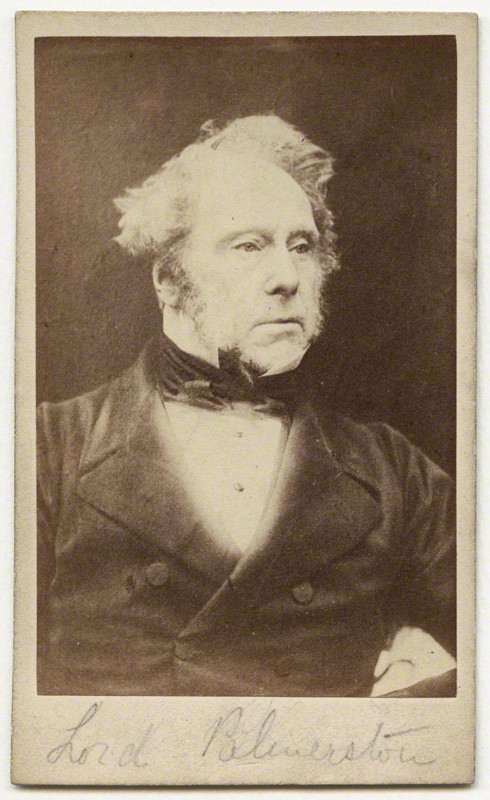
Figure 3.
A further argument against “H.W.” having been
Herbert Watkins: the famed photograph of Lord Palmerston taken by Watkins in 1857.
It is impossible to believe that Watkins would have made a microphotograph
using a picture by John Mayall instead of his own production. Image used by
permission of the National Portrait Gallery, for educational, not-for-profit
purposes.
Henry West
was born June 8, 1825 in Middlesex (London area), the fourth child and third
son of Francis and Mary West. Francis West (ca. 1789–1867) was a well-regarded
maker of microscopes and other optical instruments. He operated from several
locations throughout London, on occasions operating two or more shops
simultaneously. He was variously reported to sell from 39 Southampton Street,
31 Cockspur Street, 41 Strand and 83, 92 and 93 Fleet Street. Henry’s two
brothers, John George West (1819-1873) and Francis Linsell West (1820-1884) were
also noted manufacturers of optical instruments. John took on the operation at
92-93 Strand, while Francis took over the 31 Cockspur Street location. Henry
worked at the 41 Strand shop, probably as an employee of his father, until just
before his father’s death. The September 20, 1856 Lancet listed 41 Strand as being the business of “West, Fras., and Co.”
The first
country-wide census of England, taken in 1841, listed Francis West and his
family as living at 83 Fleet Street. Fifteen year-old Henry was recorded as
being an “apprentice optician”. At
that time, West operated shops at both 83 Fleet Street and 41 Strand.
Henry West married Jane Maria Baggs on January 23, 1850. The Chelsea St. Luke’s parish records listed both of their addresses a 13 College Street. It was quite common for
both parties to state the intended marital home as their address, or state a
family address in the same parish as that where Banns were being read.
The 1851
census recorded Henry and Jane as living at 41 Strand. Henry’s parents and
siblings lived elsewhere. They were still living there in 1861, along with
their 6 children, a nursemaid and a housemaid.
As were
many other manufacturers of optical instruments of the time, the Wests involved
themselves with the new phenomenon of photography. By 1854, Henry’s shop at 41
Strand was taking personal photographs, selling chemicals, paper and other
apparatus, as well as offering instructions (Figure 4).

Figure 4.
Advertisement from the August 26, 1854 issue of ‘Notes and Queries’.

Figure 5.
Advertisement for the novelty cartes-de-visite (CDVs), from ‘Blackwood’s Lady’s Magazine’, 1857.
As noted above, by 1858 Henry West was producing microphotograph slides from his shop at 41 Strand.
“Opticians” and “Makers of Philosophical Instruments” such as Henry West often
manufactured a wide variety of optical and scientific apparatus. Among other
things, Henry made sundials, and earned the title of “Optician and Sundial Maker to the Queen”, (Figure 6).

Figure 6.
From the 1860 ‘Official General Guide to the Crystal Palace and Park’.
René
Dagron adapted the simple Stanhope lens for service as a microphotograph
magnifier. He popularized the mounting of a Stanhope lens and a microphotograph
into a small charm of ivory, silver or other material. A person would peep
through a tiny aperture and see the magnified photograph. Henry West jumped on
that bandwagon and similarly produced “Stanhopes” (Figure 7).

Figure 7.
Advertisement for Stanhope microphotographs, from the April 10, 1863 ‘Times’ (London).
Henry West
was elected to membership in the Quekett Microscopical Club on July 7, 1865. He
retained membership through 1869.
West
relocated his shop in the spring of 1866, from 41 Strand to 3 Coventry Street
(Figure 10). The business name, “H. West
and Company”, suggests that Henry’s father was still a partner at the time.
Francis West died the following year. The 1868 and 1869 membership roles of the
Quekett Microscopical Club gave Henry West’s address as 41 Strand, suggesting
that he retained some sort of business or abode at that location.
Alternatively, he may have not bothered to update the club roster.

Figure 8.
Advertisement from ‘The Owl’, April 25, 1866. This
indicates that West produced a variety of optical and other scientific
instruments.

Figure 9.
A “Society of Arts Prize”-style microscope, by Henry
West. The addresses date this instrument to ca. 1866, when West moved from 41
Strand to 3 Coventry Street. Screenshots from an internet auction.
Henry’s
wife, Jane, died during the 1860s. She was probably the 38 year-old woman of
that name who was buried September 5, 1867 at the St. Pancras St. James parish
church. Her address at the time of death was Coventry Street, Haymarket.
The 1871
census placed Henry West living at 98 Strand. Voter registration records
indicate he remained at that site through at least 1878. This was also, at some
time, a business location (Figure 10). Court records show that West operated a
shop in the Coventry Street area during the autumn of 1870, although he had
moved a short distance to Rupert Street. The Old Bailey records also give
further information on the types of instruments that Henry West made and sold:
“Old Court - Monday, April 3rd, 1871.
James Pearce, was indicted for feloniously breaking
and entering the shop of Soloman Zucher, and stealing therein.
Henry West (testimony). I am an optician, of 98, Strand - in October last
my shop at 4, Rupert Street, Haymarket, was entered, and I lost a number of
articles - I find here some of the property I then lost; a little compass, a
log glass, brass compasses, and a small barometer.
Cross-examined. I have known the prisoner
twenty-three or twenty-four years—I have always looked upon him as a thoroughly respectable man, and the last man I should suppose would receive stolen goods.
and
Moss Benjamin was again indicted, with
Nathan Benjamin, for burglariously breaking and entering the shop of William
Ford Stanley, and stealing 25 opera glasses and other goods.
Henry West (testimony). I am an optician, at 98, Strand - I have a shop in
Rupert Street - on 28th October, that shop was broken into, and I missed among
other things, this telescope - I had had it about twenty years in stock - I
made half a dozen of them - I had three in stock at my own shop, and there were
three at my brother's in Fleet Street - the name is on them.

Figure 10.
A steam engine made by Henry West at the time he
operated a business from 98 Strand (ca. 1870-1879). Adapted from
http://le.compendium.pagesperso-orange.fr/moteur_a_vapeur.htm, for educational,
not-for-profit purposes.
Henry West
moved his home and business across the Thames River, to Lambeth, in
approximately 1880. The 1880 Kelly’s
Directory of the Watch and Clock Trades give his address as 73 Upper
Kennington Lane. The 1879 Medical
Register placed physician Daniel Colquhoun at that address. West continued
to operate an optician’s shop in Lambeth, probably staying in business until
his death in 1899.
Figure 11.
All known examples of Henry West’s microphotograph slides. Some labels have been trimmed to remove West’s initials, which also removed the series number - this may have be due to sale or resale by a shop that did not want customers to know the identity of slide’s maker. If any readers have additional examples of Henry West’s work, please contact me and I will be happy to share them here.






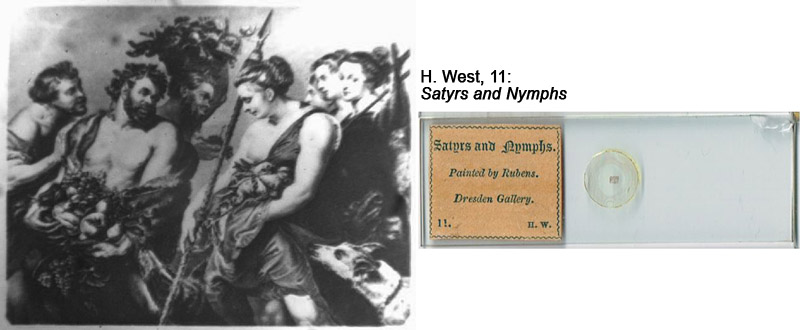

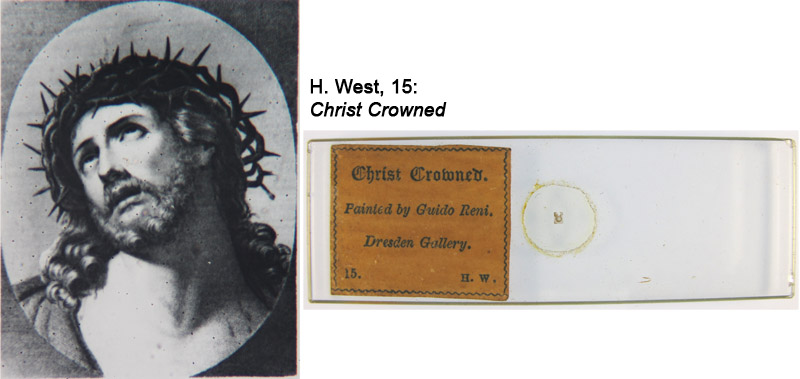









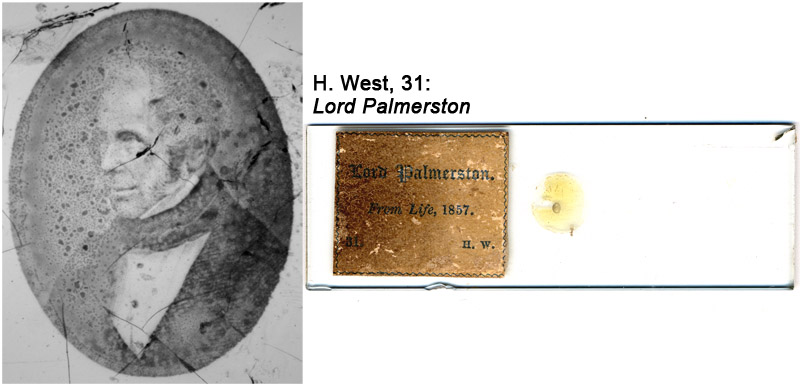
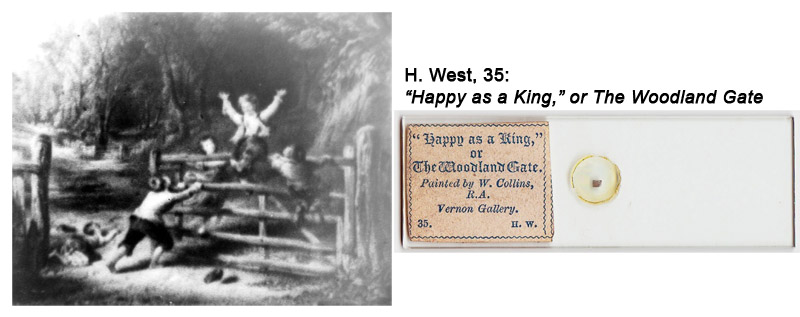







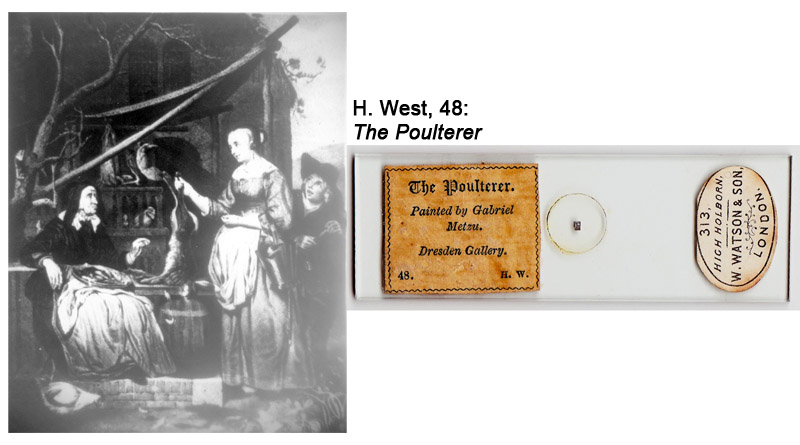





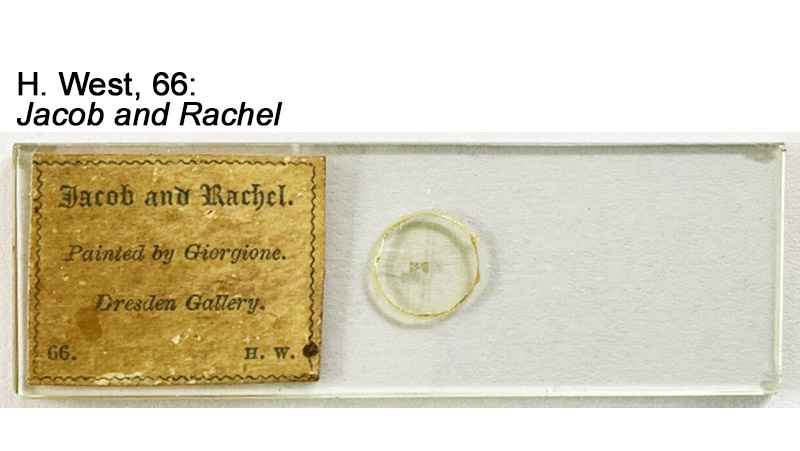













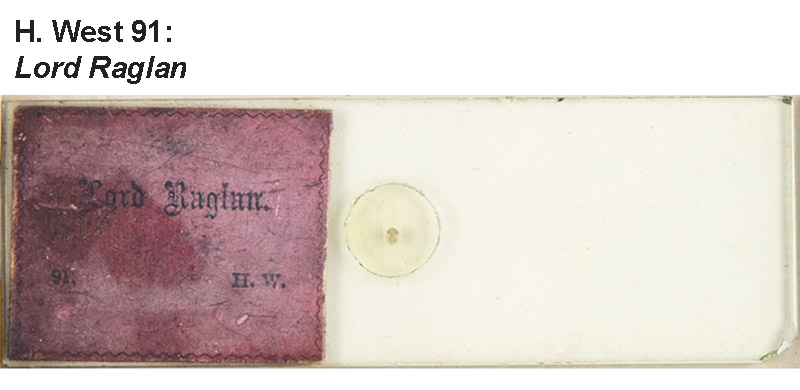












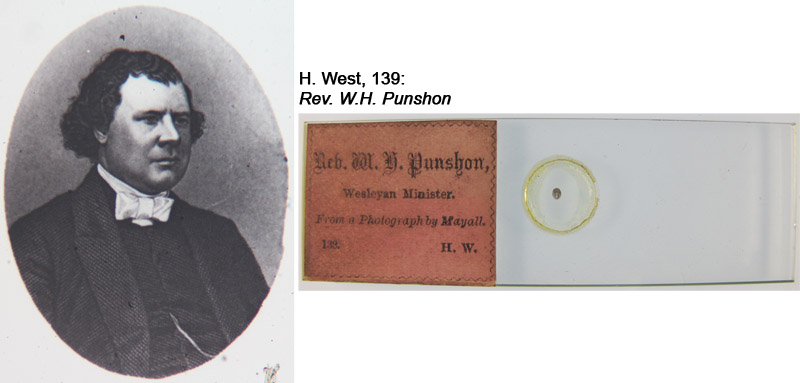












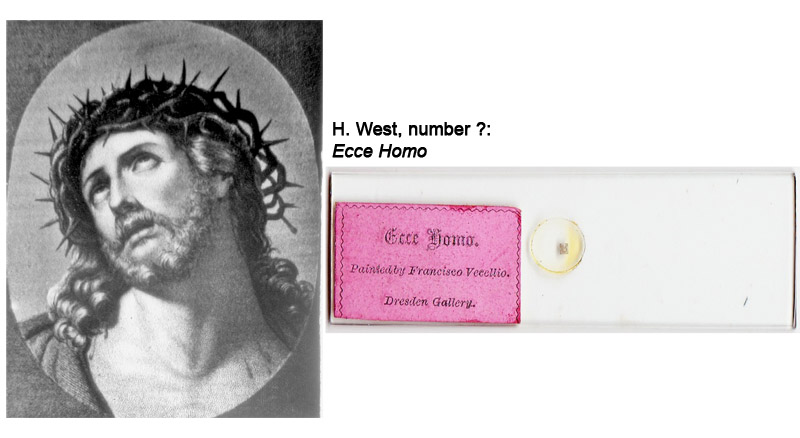
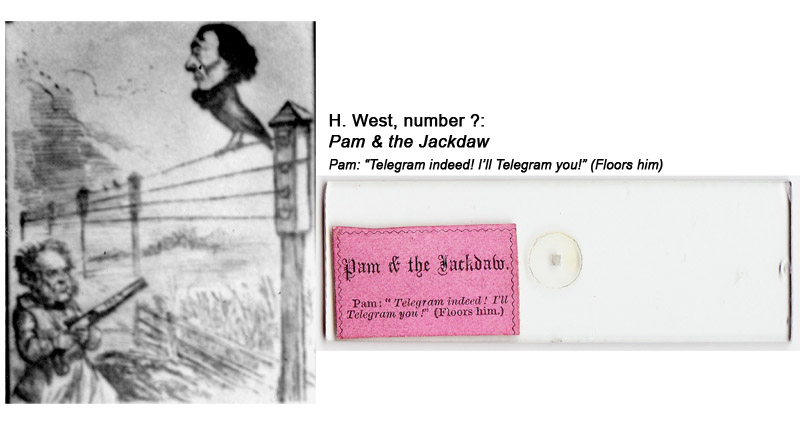










Acknowledgements
Our thanks to the National Portrait Gallery, Howard Lynk, Richard Courtier, Reg Porter, Maureen Carter, Stanley Warren, Italo Tempera, and several anonymous sources for providing images used in this work.
Resources
The Athenaeum (1859)
Advertisement from Marion and Company, including photographic cards by Herbert
Watkins, Number 1644, April, page 596.
Berly, Jules A. (1883) British,
American and Continental Electrical Directory and Advertiser, West, Henry,
optician, 73, Upper Kennington-lane, London, S.E.,
page 269.
Blackwood’s Lady’s Magazine and Gazette of the Fashionable World (1857) Advertisement for Mr.
West’s Photographic Establishment, Vol. 42, page 127.
Blackwood’s Lady’s Magazine and Gazette of the Fashionable World (1858) Science and Art. — Miniature photographs applicable to the microscope, Vol. 44, page 118.
Bracegirdle, Brian (1998) Microscopical Mounts and Mounters, Quekett Microscopical Club,
London, page 196 and Plate 46, Slides L and S.
Bracegirdle, Brian and James B. McCormick (1993) The Microscopic Photographs of J.B. Dancer,
Science Heritage Ltd., Chicago, page 121.
Christening record of Henry West (1825) St. Bride Fleet Street
Parish Records.
Le Compendium (accessed
December, 2012) Pictures of a steam engine built by Henry West, http://le.compendium.pagesperso-orange.fr/moteur_a_vapeur.htm
Electoral Register of St. Clement Danes, Westminster (1878) 1600, West, Henry, 98 Strand, House.
English census, birth, marriage and death records, accessed
through ancestry.co.uk.
Gernsheim, Helmut and Alison Gernsheim (1955) The History of Photography from the Earliest
Use of the Camera Obscura in the Eleventh Century up to 1914, unreferenced
attribution of microphotographs to Herbert Watkins, page 318.
Haigh, Biggs, Ball family tree (accessed December, 2012)
George Herbert Watkins,
http://trees.ancestry.co.uk/tree/8780576/person/715772908
Hannavy, John (2007) Encyclopedia
of 19th Century Photography, unreferenced attribution of
microphotographs to Herbert Watkins, page 1479.
Journal of the Quekett Microscopical Club (1868) List of members, Vol. 1.
Journal of the Quekett Microscopical Club (1869) List of members, Vol. 1.
Journal of the Quekett Microscopical Club (1870) List of members, Vol. 2.
Kelly’s Directory of the
Watch and Clock Trades (1880) Opticians – retail, West J. G. & Co. 92
& 93 Fleet st EC; West Henry, 73 Upper Kennington lane SE; and West Francis
Linsell, 31 Cockspur st, page 56.
Lancet (1856)
Microscope and Philosophical Instrument Makers, Vol. 2., Sept. 20, page 343.
Marriage record of Henry West and Jane Maria Baggs (1850)
Chelsea St. Luke Parish Records, accessed through ancestry.co.uk.
The Medical Register (1879)
Daniel Colquhoun at 73 Upper Kennington Lane, page 173.
National Portrait Gallery (accessed December, 2012) CDV of
Henry John Temple, 3rd Viscount Palmerston, by (George) Herbert Watkins, taken
March 30, 1857, http://www.npg.org.uk/collections/search/portrait/mw124365/Henry-John-Temple-3rd-Viscount-Palmerston
Notes and Queries (1854) Advertisement from West & Co., August 26.
Notes and Queries (1858)
Advertisement from H. Watkins, regarding his photograph of Lord Palmerston,
March 20, page 228.
Old Bailey On-line (accessed December, 2012) http://www.oldbaileyonline.org/browse.jsp?path=sessionsPapers%2F18710403.xml
The Owl (1866)
Advertisement from Henry West, April 27.
Phillips, Samuel and F.K.J. Shenton (1860) Official General Guide to the Crystal Palace
and Park, Crystal Palace, Sydenham, page 191.
PhotoLondon (accessed December, 2012) Henry West, http://www.photolondon.org.uk/pages/details.asp?pid=8304
The Spectator (1858)
Description of miniature photographs by Herbert Watkins, Vol. 31, page 936.
The Times (London)
(1863) Advertisement from Henry West, April 10.
Warren, Stanley (2006) Photographic curiosity slides – the
identification of JS and JCS, Micro
Miscellanea, Newsletter of the Manchester Microscopical and Natural History
Society, Issue 63, Pages 15-17.
Warren, Stanley (2007) Initials on microphotographs –
thoughts on AR, Micro Miscellanea,
Summer issue, no. 66, pages 20-29.
Warren, Stanley (2009) Studying microphotographic slides, an
update to current knowledge, Journal of
the Microscope Historical Society, Vol. 17, pages 35-50.
White, Robert (1843) Atlas
Ouranios, T. Parker, pages 49 and 53.






























































































